Space Shuttle Launch Complex 39-B Construction Photos
Page 3
OMBUU Arm Lift 3 (Original Scan)
Top right photograph is Wade Ivey (owner of Ivey Steel) and Rink Chiles (Ivey Steel ironworker general foreman, both facing away from the camera) and a gentleman who's name eludes me who worked for Olson Electric.
And, despite all the dislike for the camera I was carrying around, and disapproval of what I was doing with it coming from all quarters, it was really cool being able to wander around all over those towers with that camera and grab shots, in case anybody is wondering what that might have been like.
The camera was a kind of get-out-of-jail-free card, and also served as my hall pass for going to an awful lot of out-of-the-way places that you might not ordinarily be expected, or even allowed, to go, and I employed that shit to the fullest, every chance I got.
I had a fucking NASA-issued camera permit. On the permit it said "restricted and unrestricted areas." In plain English, that means: The Whole Goddamned Space Center. The fucking permit gave me full photographic access to anything and anywhere I could get to with the badge (which itself had clearance for a surprisingly broad range of locations, almost all of which I had no official reason to be visiting) I was wearing. I'm permitted, so please take your fucking scowl down the road somewhere, 'cause I'm not gonna stop doing what I'm fucking permitted to do. It was great! One of the very best parts of my whole goddamned multi-year experience out there.
Once my boss, Dick Walls (who was like a second father to me, and who I will never be able to thank enough, and who caused my entire life to take a radical turn for the better) allowed me to leave the field trailer when things were slow (which was surprisingly often), I became the captain of my own vessel. The tiller was in my hands, and I could steer in any direction I wanted to.
Maybe stop and think about that for a bit. Here's a guy who's been released from work for the next hour or two by his boss, with a camera in his hands, and a whole fucking launch pad to explore and take pictures of. And not just any launch pad. No, not at all. From this one, they flew to the fucking MOON, and from this one, they would fly the fucking Space Shuttle! It was almost more than I could bear. It was so far beyond belief that I still, to this day, have trouble understanding my insanely good luck in being able to do this. And I was the only one. Nobody else on that whole pad was given official permission to just wander around, snapping pictures of Unimaginable Wonders of the World. I dunno. I just do not know. Nor shall I ever know. It just was, and that was that.
Additional commentary below the image.
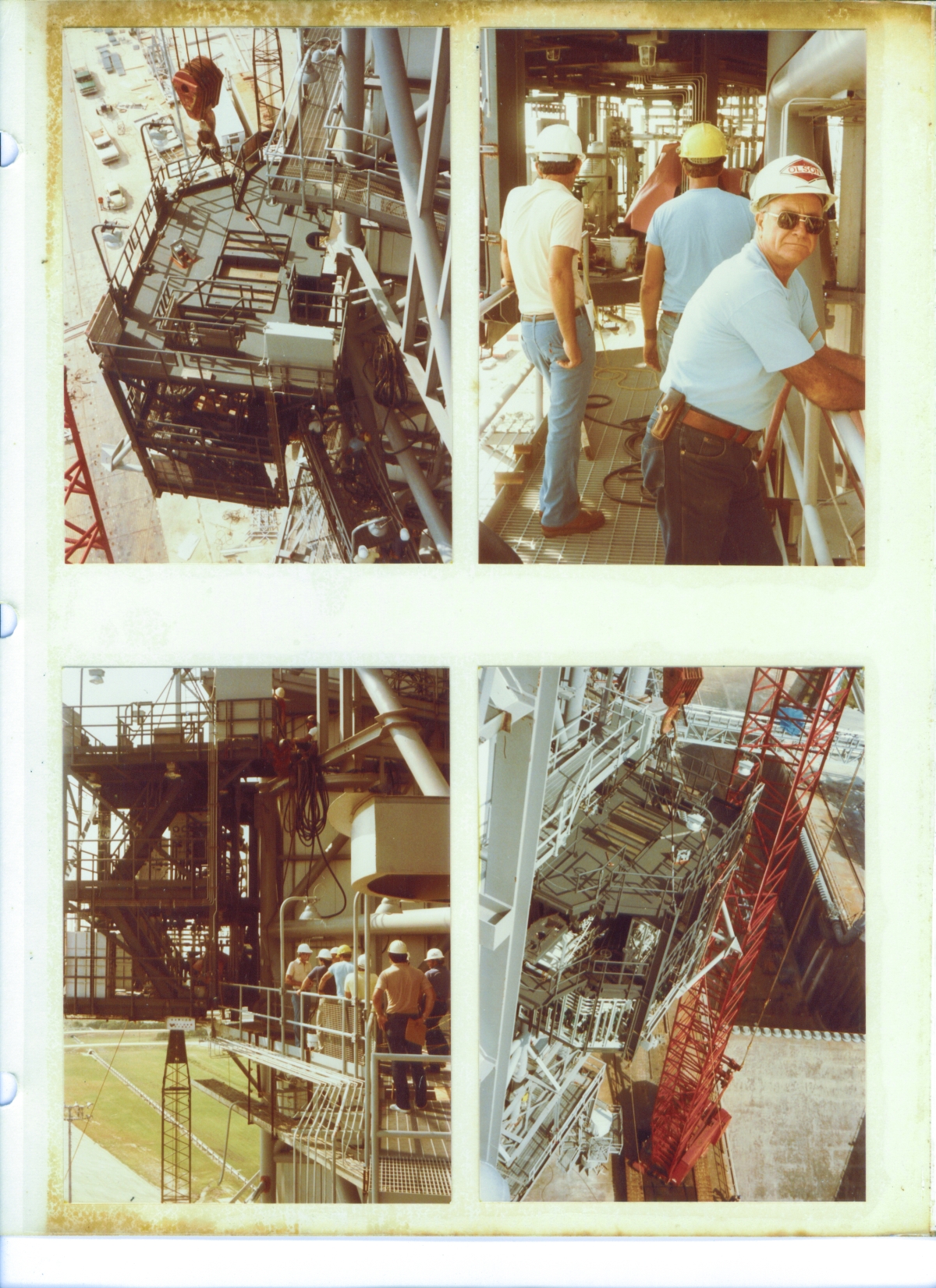
Top Left: (Full-size)
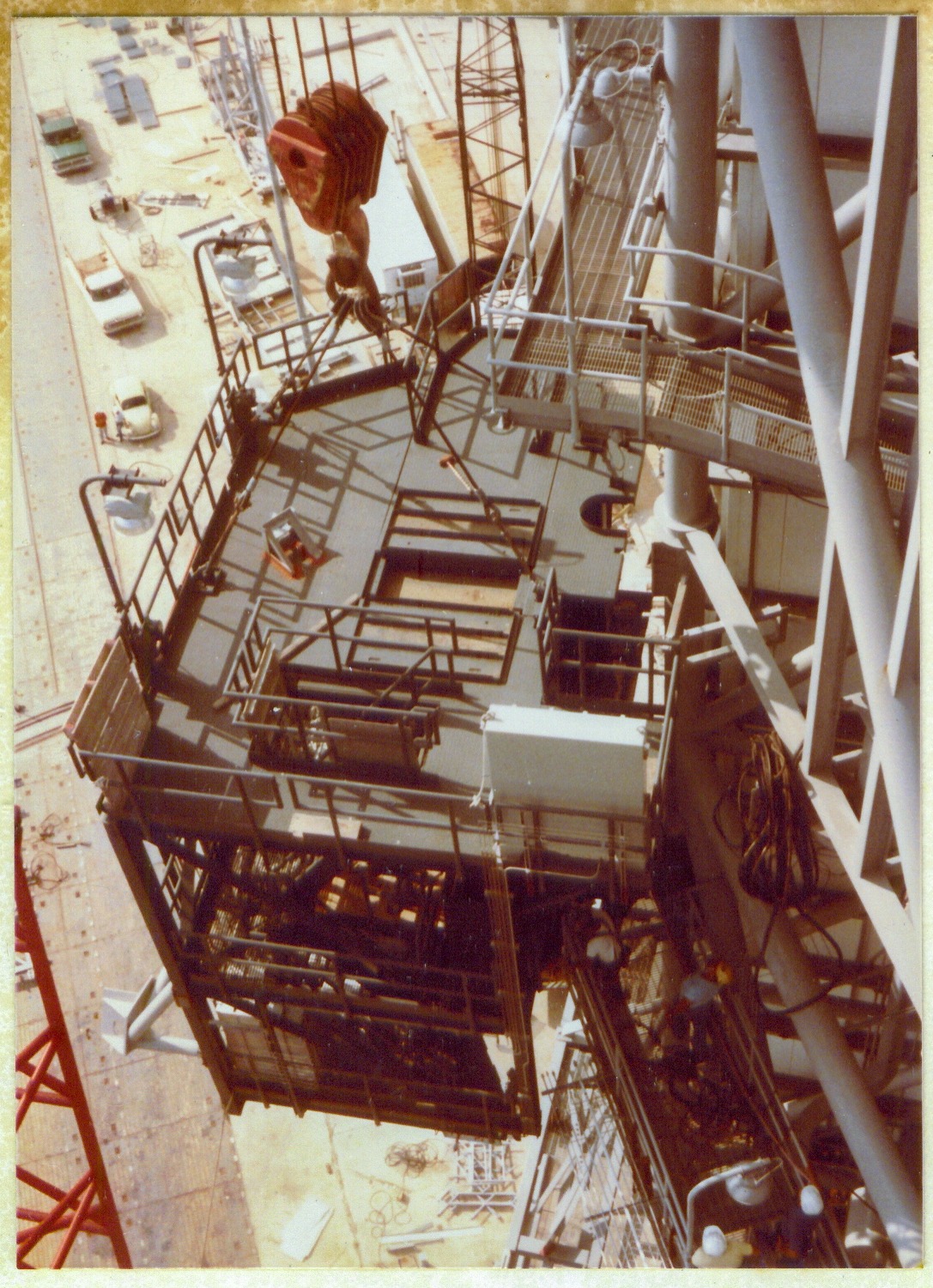
Almost there. Once they got close, I ran over to the elevator, ground level on the FSS, and went up to what appears to be perhaps the 240 or maybe the 260 foot platform elevation level and walked over to the southeast corner where I could get a good angle looking down at the OMBUU now almost in contact with the RSS, and grabbed this frame.
There's lots going on in this image, and we're going to talk about it, but first we'd better get our bearings. We'd better get some kind of handle on where we are. On how far above the pad deck we are. On where everything sits in relation to everything else.
The place is deeply complicated, so get ready, ok?
Let's look at that elevation view of the whole setup, Space Shuttle and all, one more time, and this time we're going to need to try and understand what we're looking at.
In the previously-linked drawing, (here, let me link to it again, just to be sure you're looking at the right one) which you're looking at in what is called an elevation view, you can see, from left to right, the central parts of the RSS, all of the FSS, and the Space Shuttle, which is sitting on top of the MLP (Mobile Launch Platform), which itself is sitting on top of the Pad Deck, cut into which beneath it is the Flame Trench.
Got it?
Maybe give it another look, just to make sure.
And once you've given it another look, now you can compare it with the isometric view, which I originally linked to on the first page of this thing, and will link to again, here.
Both the elevation view, and the isometric view, are showing us the same thing, with the only sensible difference being the inclusion of the Space Shuttle, sitting on top of the MLP, in the elevation view. The Shuttle and MLP are not included in the isometric view.
Ok?
Ok.
Now, please go back to the elevation view and maybe zoom in on it some, and you will see that the actual elevations of things are included, but of course they've got to make it complicated and you should immediately notice that they've got more than one set of elevations for everything, which means that there are multiple different listed elevations for the same goddamned things!
Gah.
For the purposes of what you will henceforth be dealing with, coming from the hand of James MacLaren as he writes these words, you will be given everything in terms of "FSS CONSTRUCTION ELEVATIONS (MSL)" from now on, unless there's some reason for using something else, and if that happens, I'll warn you. The buttons inside the FSS elevator would be a case in point. They were labeled with the elevations from over on Pad A. The little "(MSL)" at the end of "FSS CONSTRUCTION ELEVATIONS (MSL)" means that all such elevations are in respect to Mean Sea Level (MSL). On the coast of Florida, the difference between sea level, and ground level, is trivial. They're damn nearly the same thing! This is the system that was in use at the time we constructed the pad, and this is the system that will be in use for the balance of what comes.
Go back and look at that elevation view yet again, and find where they've listed that "FSS CONSTRUCTION ELEVATIONS (MSL)" so you can come back to it as often as needed, to keep things straight in your mind as to just how high above the ground, or perhaps the pad deck, we were when whatever I'm describing was going on. Print the sonofabitch out, if you have to, and keep nearby. Presumptions will be made. Presumptions will be made that you in fact know this stuff, in all that follows. Be ready for it, ok?
Using this system, the top of the FSS (but not the top of the Lightning Mast, which was on top of the Hammerhead Crane, which was on top of the FSS), was at elevation 300 feet.
In truth, it was only 250 feet above the unfeelingly-incompressible surface of the Pad Deck, but that's still a pretty good drop, and when you start getting up that high, and especially if you're going to be walking high steel at that kind of elevation, the fifty feet more, or less, doesn't really even matter. You don't even notice it. You're already plenty far enough up into the air.
Ok, that's enough of that. Let's get back to "There's lots going on in this image."
You can click on this image (and all the rest of my images too) and it will open up all by itself in a new tab in your web browser, and if you do that, you can click back and forth between the tabs so you can periodically get a look at the image to get a better understanding of what I'm writing about. If you like scrolling up and down on just this page alone, well then, by all means suit yourself. But for me, it's easier to switch back and forth between tabs when somebody's going on and on about minute little details in some damn picture or other, and I'm trying my hardest to understand what the fuck's going on, and that goes double for subjects that I'm not particularly conversant with in the first place, like maybe building launch pads or something like that.
Get a look at the top, dark gray, surface of the OMBUU, and find the cutout over on its far right-hand side with a nice half-round curve that perfectly matches the size and roundness of the lighter-gray vertical structural pipe with a couple of flat collar-looking flanges on it and an I-beam coming into it at an angle, extending down and to the right in this image. The actual connection plate is visible as a squared-off shadow, which is part of a weldment that's just below where that I-beam comes in to the vertical column.
That cutout in the the top of the OMBUU will be flush against the steel column, or pretty damn close to it, when the OMBUU is bolted up to the RSS. Looks like they've got maybe a little under three feet to go, horizontally, and they're pretty much dead nuts already, vertically.
Whether they continued to boom right, or stopped short and used come-alongs to finish sucking in the OMBUU, up against the RSS, I do not know.
An ironworker using nothing more than a chain come-along and his own muscles can exert a tremendous force upon, and move, truly surprising objects with it. Maybe one day I'll tell you what I saw five of Wilhoit's ironworkers do with the entire RSS Bottom Truss, just inboard of Column Line 1 all the way out to just inboard of Column Line 7, Column Lines A to B, which was a single gigantic weldment over a hundred and fifty feet long and thirty-five feet wide made out of very heavy pipes that ran in the one to two hundred pounds per linear foot weight range, using just chain come-alongs and muscle, up on top of the falsework that had previously been put in place to carry the weight of the whole RSS as it was being assembled, prior to that weight finally being let down on the drive trucks resting on the steel rail out beneath Column Line 7 on the pad deck. What I saw that day still causes me to doubt my own eyes. So yeah, if they needed to suck the OMBUU into the RSS with a come-along or two, it would have been easily done.
Needless to say, looking at this image, you can tell that there's really nowhere for the OMBUU to go, except for exactly where it's supposed to go. The marvel is that it's all worked out in advance, using nothing more than a little geometry and trigonometry, and it always fits perfectly. Pay attention to that math shit in school, children, because you never know when, some fine day fifteen or twenty years off into an opaquely-unseeable future, you'll find yourself clapping your hands in glee at the outrageously cool shit they'll let you get into once you demonstrate to them that you can handle it.
Unless, of course, somebody fucked up on the engineering, or failed to take into account every last thing in the area. Which happens, and is the source of Great Disagreements on behalf of the parties who might be liable for the costs incurred when you're renting one of those big Manitowocs and paying for a crew of union ironworkers, and you wind up wasting a full day or more in an attempt to "make it like the drawing shows" (which is something the pointy-headed engineers never tire of spouting in your face), even when the drawing shows something that's plainly impossible, once it's compared to the real-world setting it's supposed to fit into.
Down at the very bottom edge of the image on the right-hand side, wearing his white hard hat and yellow shirt, Wade Ivey stands beneath a lighter-gray light fixture on the access catwalk to the OMBUU, keeping a close eye on things.
Far below, down on the ground to the left of the OMBUU, it looks like Howard Baxter is also still keeping a close eye on things, along with his TT&V buddy, who's slouching casually on the front fender of my ratty little VW.
Top Right: (Full-size)
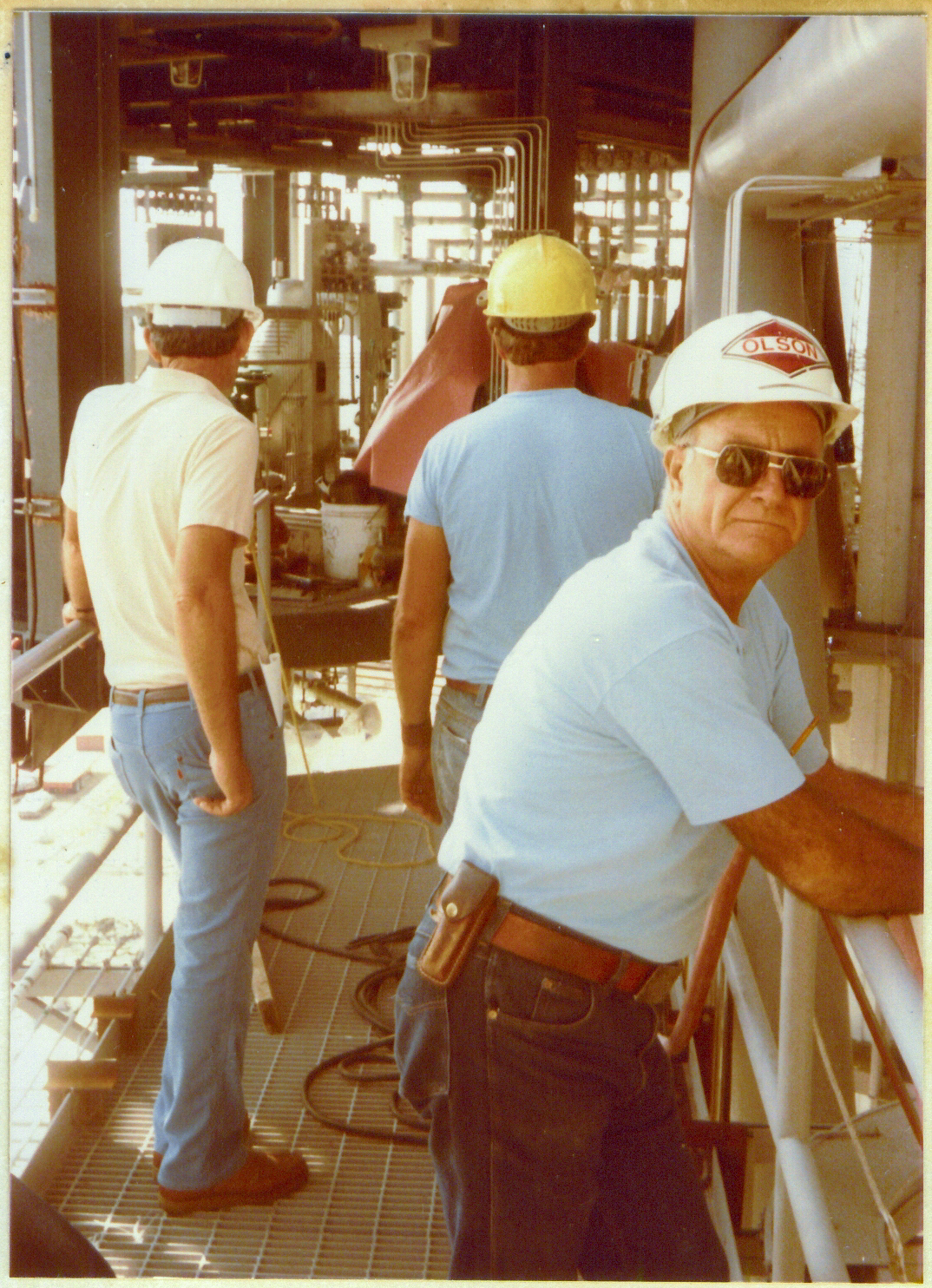
And now I've come down a few levels on the FSS and have walked out on to the access catwalk for the OMBUU itself, on the RSS. I was all over the place with that damn camera whenever this sort of thing was going on, trying to get as many differing views of things as I could, trying to show as much as possible about what was going in in the resulting pictures. And while all that was going on, I was also trying to stay the fuck out of the way, and also trying to stay the fuck on top of the structure and not "step in the hole" anywhere along the line, while squinting through the viewfinder on the camera. It's much easier to go over the side, or into an open hole, than you might imagine, so you have to be very mindful of that kind of thing at all times, even when your mind is closely focused on whatever else it is that you're doing or looking at, at the time. The penalty for getting this one wrong is severe, and you do not want to get penalized in this manner.
Ok, back to the OMBUU access catwalk. Wade and Rink are right there, giving things the close scrutiny they require. Olson Electric's general foreman is giving the camera an unfriendly look. Wish I could remember his name, but it's gone. He was a decent enough sort, but he was also an electrician and as such, played a roll as both friend and enemy to the ironworkers working for Ivey Steel.
The craft labor broke down into three major categories on this project, and those categories were Structural, Mechanical, and Electrical. Each major category had its own areas of expertise, and saw to them to the exclusion of all else (which will become important here in just a minute). Nobody was going to be able to do anything until the ironworkers built the main structure first, of course, but once the main meat and potatoes of that was in place, the pipefitters (Mechanical), and the electricians (Electrical) would be all over the place laying in their piping and cabling, and this would be ongoing even as the ironworkers continued to flesh out the bones of the main structure with the ongoing installation of miscellaneous metals as well as constant stream of greater or lesser modifications or additions to the main structure, as dictated by the customer and end user, NASA.
So far, so good.
But if one craft was attempting to install something, and another craft's handrail, pipe hanger, cable tray support, or whatever, was in the way, and engineering had failed to account for it on their drawings (happened all the time), then things got interesting.
To begin with, those engineering drawings were the law. Break the law, take the penalty, pay the price.
But it was never as straightforward and simple as that, no matter how many little exculpatory clauses were plastered all over the drawings and sprinkled throughout the specifications, to the effect of it being the contractor's responsibility to verify all existing conditions prior to commencing work, and accounting for said existing conditions as part of their firm fixed-price bid.
This is bullshit, and it will not stand up to any proper scrutiny, and even though the customer and their engineers knew that, they would still relentlessly and everlastingly attempt to enforce it (but only to their own scheduling and budgetary benefit, never the contractor's).
"Make it like the drawing shows," the engineers would smugly condescend to you, but if the drawing fails to show, or incorrectly shows, something in the way of the platform you fabricated precisely to the dimensions of that drawing, blocking you from bolting the goddamned platform on to the existing structure, well then it's your fault, and you will modify your platform to suit the existing condition, and you will do it at no additional charge to the customer, and you will do it without being given any scheduling relief for the hard date that we set for completion of the work, and you will also do it per the direction and instructions of the customer's engineering department, to whom you will first submit your planned alterations for approval and then wait until you receive official notice to proceed with with altered scope of work while those engineers review your submission.
Fuck. That. Shit.
The crooked sonofabitches were essentially telling you to do their design and engineering for them, with no additional schedule or cost increase accruing to themselves.
Not gonna happen, Bucko. You can take that shit right down the hall with you to somebody else's door, and please try to not let my door hit you in your thieving ass on your unworthy way out of my goddamned office.
And so we find ourselves up on the OMBUU access catwalk, with the OMBUU still not connected (There's a fair bit of daylight showing, hip level between Wade and Rink. Don't step in the hole, remember?) and Olson Electric's guy just kind of hanging around, all casual-like, enjoying the pleasant weather up there.
And what the fucking hell might that have to do with "make it like the drawing shows" I hear you ask?
Another good question.
It's because the different trades will cheerfully snipe at each other, and each group needs to keep a close eye on what the other groups are doing, lest something expensive befall them at the hands of another trade.
We've already learned what a monumental pain in the ass it can be when things do not quite match the drawings, and since time is money, it behooves Wade and his ironworkers to get the goddamned OMBUU bolted on to the RSS as fast as they can.
And if, as sometimes happens, there exists perhaps a bit of 3x3x¼ angle iron on the RSS, which might be there to support a bit of nitrogen purge tubing, or perhaps some mineral-insulated cable, or whatever, to be furnished and installed at some future date by others, and it's in the way and it's keeping the OMBUU from mating flushly against the steel of the RSS, and nobody's around watching, or sometimes even if there is, the ironworkers will simply torch the sonofabitch off, and then go merrily about their business of bolting the fucked up OMBUU to the tower.
And so, things rapidly devolve into a game of "Who got there first?"
And sometimes the guys who got there first win, and sometimes the guys who got there first lose. Sometimes you're the giver, and sometimes you're the receiver.
It all depends.
And so, Olson's guy is there, watching, and I'm sure the pipefitter's guy is lurking somewhere nearby, too.
Let them go and request a change order from NASA. Let them deal with existing conditions. We haven't got time for this shit. We need to hang this fucking OMBUU on the tower. Today.
Bottom Left: (Full-size)
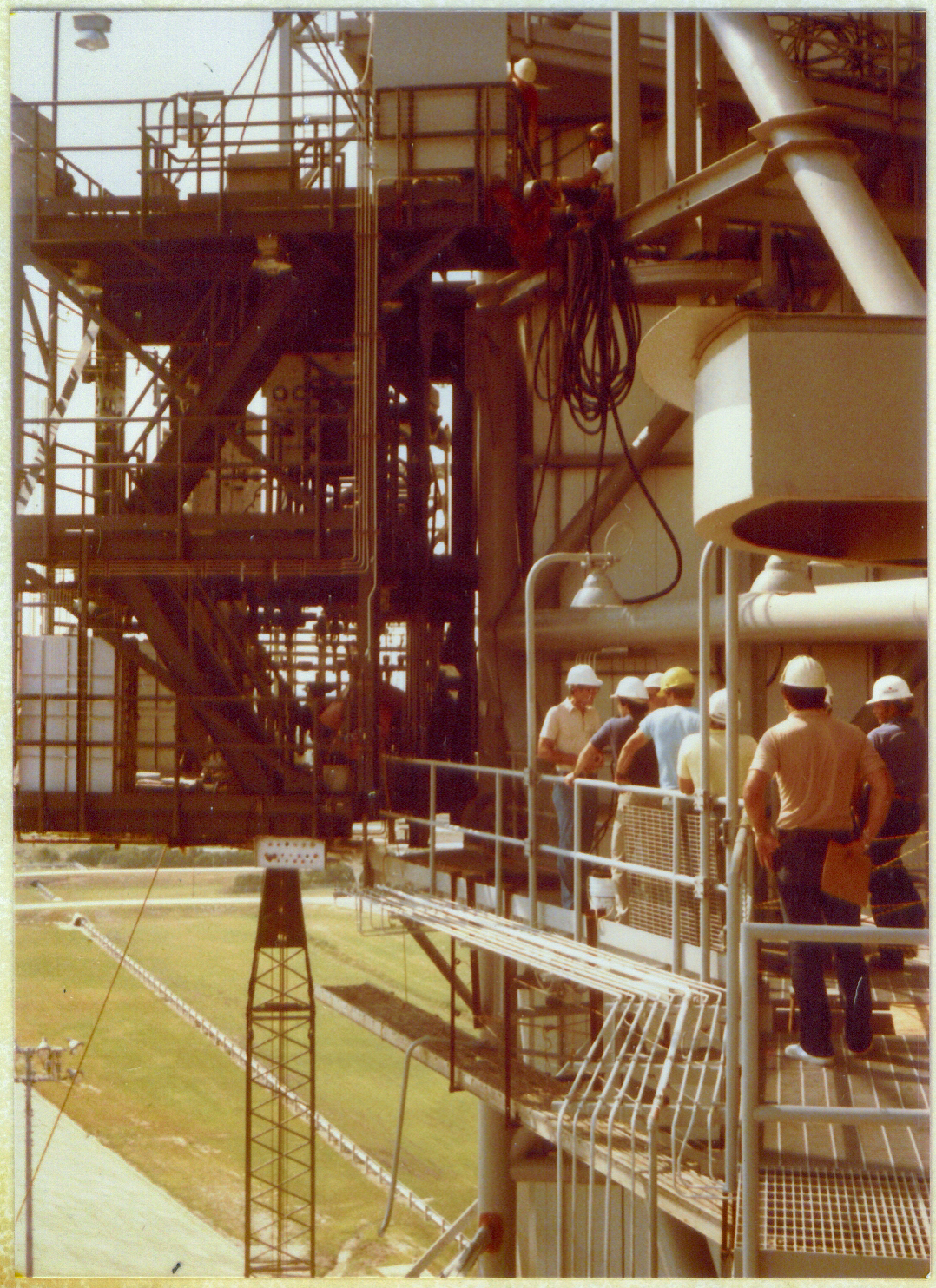
And now we've backed farther away from things, looking from over on the FSS once again, and can see the number of people involved. The sightseers that originally appeared in images of the lift, down on the pad deck, are not in attendance up here. These are all people with a direct interest, whatever it may entail, in the business of fastening the OMBUU to the RSS.
Also, my surmise above, in the verbiage for the Top Left photograph, is now proven wrong, which goes to show just how easy it is to misapprehend things you are looking directly at. From here, it's abundantly clear that the OMBUU is still a foot and a half to a couple of feet high as can be clearly seen via that daylight which is still showing between the OMBUU itself, and the end of the access catwalk to it, right there behind Wade Ivey, as well as the handrail elevation mismatches between the access catwalk and the OMBUU itself. You find yourself oftentimes looking directly at something, and either not seeing something that's there, or seeing something that's not there. Funny how that kind of thing works, sometimes.
Since I was in no way directly involved with the connection work itself, I have no idea what might be going on with keeping the OMBUU up where it still is, but we've already discussed those sorts of things generally, above, and will just have to content ourselves with something along those lines as a proposed, but completely unproven, explanation for things.
Bottom Right: (Full-size)
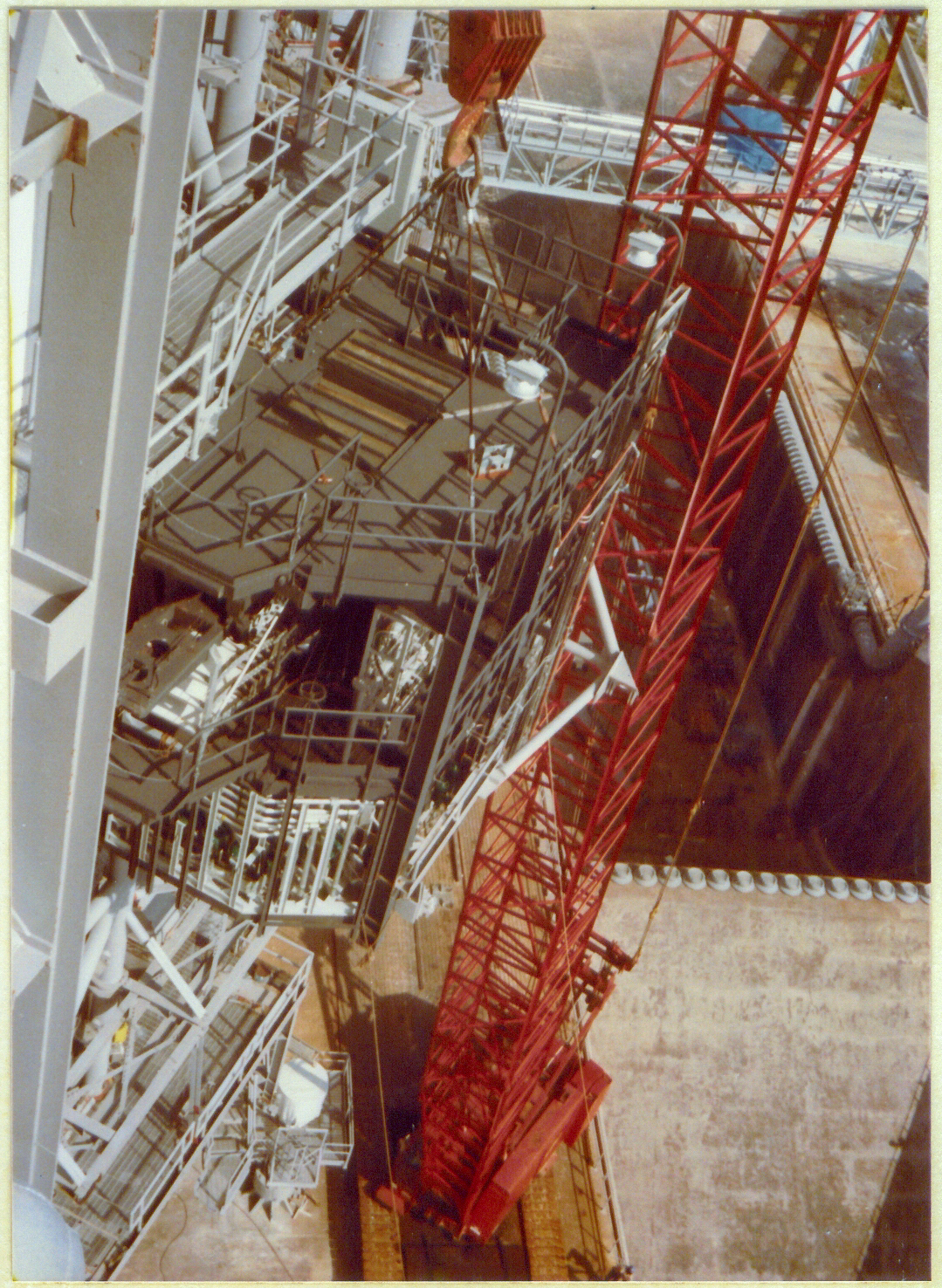
And now I've moved over to the other side of the RSS from the OMBUU, most likely up on the SRB (Solid Rocket Booster) access platforms which lived on either side of the RCS Room (Reaction Control System), and protruded a pretty good ways out in front of the RSS, and provided a pretty unobstructed view of things, but I do not remember for sure, and this might be wrong.
Wherever I'm shooting from, it not only lets us see the OMBUU from a completely different perspective, but it also gives us an excellent look at the crane cab, looking back down the boom toward the ground, which is probably why I picked this location and framed this shot the way I did. Directly to the right of the crane cab, the lighter gray Fondu Fyre coating on the Flame Deflector can be seen, and above that in the image, the darker shades of the Flame Trench itself yawn open widely, set against the lighter shades of one of the comb-like SSW Water Headers over there on the far edge of the trench.
And so, whilst admiring the beautiful view from up on high, in the arch-perfect Florida weather, we shall conclude our little presentation on the OMBUU lift, and move elsewhere. There's more work to be done, and more pictures to be taken.
Lots more.
Return to 16streets.comACRONYMS LOOK-UP PAGEMaybe try to email me? |